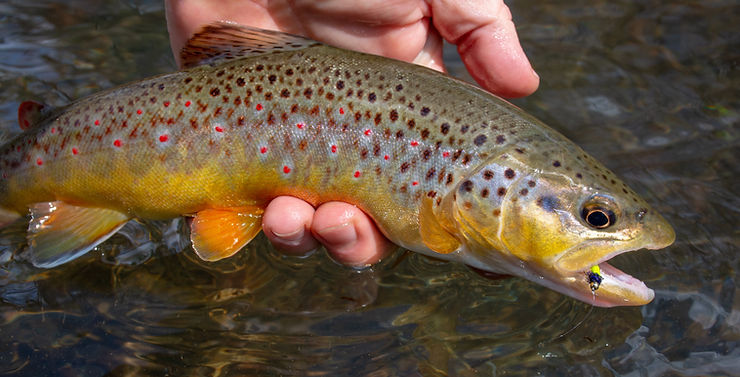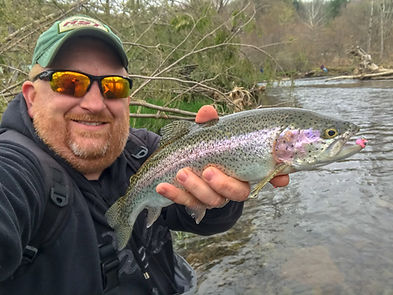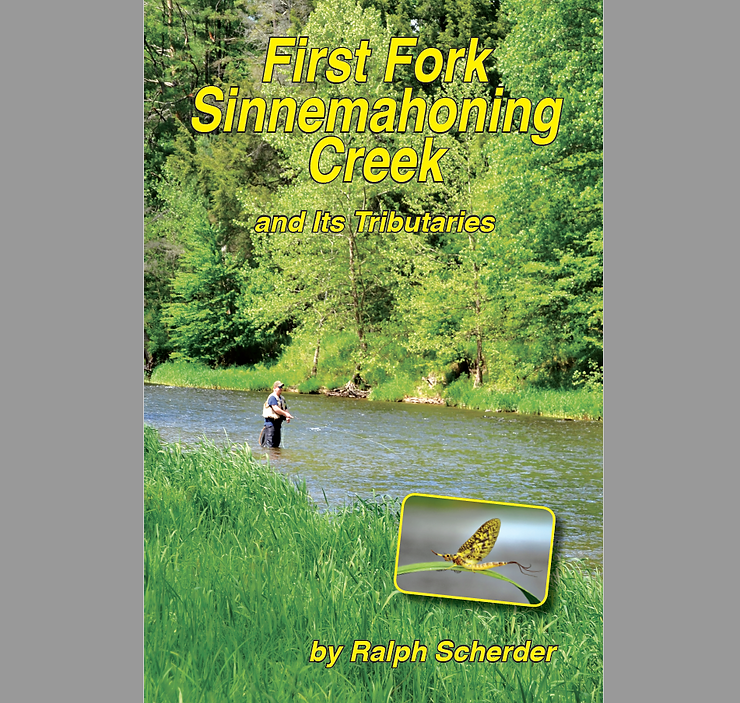Home Waters: First Fork Sinnemahoning Creek

There’s a ritual to arriving at camp. I unlock the door and step inside where it’s nice and cool and the air has that familiar, camp smell. Turn on the electric, fire up the wall heater, and bring in whatever I need from the truck. And then it’s time for the best part, the daunting task of trying to decide where to fish.
I say daunting because, when your camp is in Potter County, and your home stream is First Fork Sinnemahoning Creek, the options are seemingly endless. It’s hard to narrow it down to just one spot to spend an afternoon.
I opted for a stretch that I’ve fished countless times and the first trout I caught was a wild brown with brilliant red spots, even on its adipose fin. I was relieved to catch that wild brown so far downstream from what I’d consider First Fork’s wild trout water. In recent years, Potter County has been prone to drought, which has taken its toll on certain fisheries. Last summer, First Fork got so low that I swear there were more rocks than water in many sections. Temperatures creeped into the upper 70s throughout much of its length, and I wasn’t sure how the wild trout had fared. Hopefully this fish is an indicator that they survived just fine.

To be honest, I’m amazed that First Fork doesn’t have more wild trout. The upper stretches have good populations of both wild browns and native brook trout, but not in the densities of a Class A stream. All throughout its length you’ll find a scattering of wild and holdover browns, though, and they always seem to pop up in places where you least expect them. For instance, one of the largest wild browns I’ve ever seen was in a pool directly behind Hemlock Campground, which is probably the most heavily-fished section of First Fork – not counting the DHALO.
I spent many years throughout my teens and twenties searching for a lunker wild brown in First Fork. Occasionally I saw one that would raise the hairs on the back of my neck, but they were few and far between. I know rivers and streams where big wild browns are more plentiful, and where it’s not uncommon to latch onto one on almost every outing, but there’s something special about a huge First Fork wild brown. I don’t know if it’s because there aren’t as many of them here or if it’s because this is my home water.
Downstream from where I caught the wild brown, I came onto a long stretch of riffles where I knew trout liked to pile up. Immediately I noticed a few splashy rises and clusters of Grannoms in the air. I picked up two trout on a size 16 Elk Hair Caddis and then walked the bank trying to pick out more risers. Further down, six guys were lined up around some deeper water where the mother load of trout was no doubt congregated and three more surrounded a decent pool near an undercut bank. They must’ve all known each other and were discussing plans to pack up and head home. It was Sunday afternoon and they had a long drive ahead of them – and besides, the trout weren’t hitting.
I slipped in between the two groups of guys and cast into a sliver of water behind a stream deflector and immediately hooked and landed a feisty rainbow. I felt all eyes on me, and as much as I wanted to land a second trout on my very next cast, I didn’t catch anymore in that particular pool.

In less than 20 minutes, I had the stream all to myself. The sun came out briefly and a flurry of Grannoms sprang from the riffles below and fluttered upstream. Three or four trout began to rise along the far bank of a very deep pool. It took a long cast and lots of mending to get a good drift, but each time the fly hit a feeding lane, a trout came up and took it in. I caught three fat rainbows before the rises stopped.
It began to rain and I noticed a few trout rising around the undercut the three guys had been fishing. They totally ignored the Elk Hair Caddis, so I tried a brown size 16 X-Caddis. Two trout hit with open mouths, and when I set the hook, the fly came right out. A few minutes later the trout continued to feed.
Trout that have been fished over hard will often hit with open mouths, especially if the fly you’re using doesn’t match exactly what they’re feeding on. This happens a lot on special regulations sections where the trout have been caught and released multiple times. You’ve convinced them enough to rise, but not enough to make them want to eat the fly.
When this happens, the first thing I try is a fly of a slightly different color. In this case, I went with a green X-Caddis, but no luck. So I went to my second option, which was to try a smaller fly. Again, no luck. And yet still the trout continued to rise.
The rain was coming down a little harder now and I noticed a mayfly struggling on the water’s surface a few feet out. I waded out and captured it with a cupped hand. I’m no entomologist, but I know a Quill Gordon when I see one. Once I looked closer at the water’s surface, I noticed other Quill Gordons struggling to take flight in the rain.
I tied on a size 14 Quill Gordon, and it took a few drifts, but once I got it right, a trout came up and inhaled the fly as if it were the most natural thing in the world. A few minutes later, I caught a second, and substantially larger, rainbow from the undercut pool, and once again, the fish had sucked in the fly without hesitation.
As I was releasing that fish, it started to pour. I thanked the trout for testing my skills and let it slide from my fingers. When I looked up, I noticed that all of the Grannoms and Quill Gordons were gone. The hatches were done for the day. I headed back to camp and put a pizza in the oven and enjoyed camp life for the rest of the evening.
Next day, I walked in to fish the stretch behind Hemlock Campground and immediately noticed two palomino trout finning in one of the pools. A handful of other trout were rising for Grannoms.
I tried everything I had but just couldn’t get any takers on dry flies. For one, the bulk of them were stationed and feeding near the opposite bank, and there were just too many tricky currents between me and the fish to get any sort of a decent drift. So I tied on a tandem rig that consisted of a white and pink Y2K as the point fly and a green Simple Caddis dropper, and I quickly picked up a handful of trout on the dropper.
Any time I’m fishing a tandem rig on a stocked stream, I almost always have an egg pattern as my point fly. Egg patterns are typically bright and get the attention of the fish. Although I may end up catching most of the trout on the dropper, it’s the egg pattern that pulls them in. Of course, the point fly doesn’t have to necessarily be an egg pattern, but it should be something bright and flashy.
In some cases, I’ve switched out the point fly in hopes of finding one that would catch fish as often as the dropper. But almost every time, the effectiveness of the dropper diminishes, and I end up catching fewer trout overall. It’s definitely something to keep in mind with tandem rigs. It’s good to keep track of which combinations work best together.
The larger of the two palominos was stationed about two-thirds of the way across the stream and in among some rocks. The water was shallower there than in the pool between us, but I noticed that the fish made a move toward my flies when one of my casts got reasonably close.

To adjust, I slipped on a strike indicator only about two feet above my point fly and dropped the whole presentation about 10 feet upstream of the palomino. The strike indicator drifted over the trout’s head, and when the flies underneath reached the fish, I saw the trout’s mouth flex and the strike indicator jerked under. I set the hook and the palomino thrashed and wallowed up to the surface.
It was a good fight and my first palomino of 2021, about a 16-incher. I released it and retied my flies just to make sure the knots were strong. When I looked up again, the palomino I’d just caught was gone, nowhere in sight. I eventually relocated the fish in a riffle about 100 yards downstream. I think this happens a lot with fish that are caught and released – especially stocked trout. A percentage of them simply pack up and leave.
I fished my way downstream, picking up a trout here and there, a couple of them on the Elk Hair Caddis. I switched back to a tandem rig when I got to the next big pool and immediately hooked into an 18-inch rainbow that was, hands-down, the hardest-fighting trout I’ve caught all year. The fish was long and fat and had tons of spunk.
You know you’ve latched onto a good one when your heart starts pounding and you feel that rush of adrenaline. My hands were a little shaky as I plucked the pink and white Y2K – yes, got him on the point fly! – from his lip and watched him fin back to the pool from which he’d come.
It was around one o’clock in the afternoon and dark clouds were forming over the mountains in the distance. Every year, I make a point to explore new streams, new parts of the state, and experience the many opportunities available to fly fishermen in Pennsylvania, and I certainly enjoy every bit of it. But there’s something about Potter County and the First Fork Valley that speaks to my heart like no other place I’ve ever been. No other place could ever match it or give me that same feeling of home.
I hooked up my rod, satisfied with the day’s catch, and headed back to camp for lunch.
___________________
If you’re interested in learning more about First Fork, its hatches, access points, and a little bit of history of the area, please check out my book First Fork Sinnemahoning Creek and its Tributaries, which is available in print and digital download in the online store. To learn more about this book, CLICK HERE.



I think the wild trout population is class A from Costello up.
At least based on what I catch. Over 60% wild.
Definitely a lot of wild fish in First Fork in the upper section. Would be interesting to see what would happen if they stopped stocking it, or perhaps stocked it with fingerlings instrad of adult trout.
I have been practicing catch and release for over 20 yrs, my opinion and only my opinion if we could get more and more people to do the same there would be more trout for everyone to enjoy. I have read a lot about streams out west and its different here, as much as we dont want to believe it it is. Everyone pays for a license and they have a right to do what they want, but I truly believe if we all think about catch and release vs keeping the trout our waters would have more trout, trout will breed in the streams naturally and the populations would grow and grow. The sound of the metal fish stringer makes me cringe but who am i to say its wrong. I am curious though how many more anglers think like me but dont get the chance to voice their opinion.